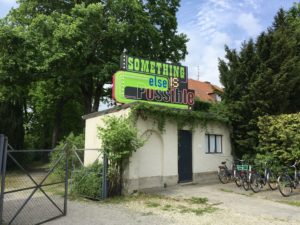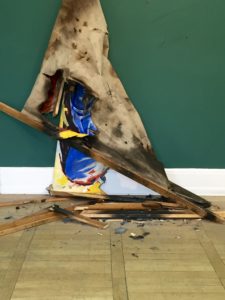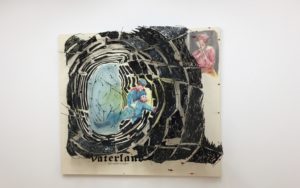“Vermisst: Der Turm der blauen Pferde von Franz Marc” at Haus am Waldsee, Berlin

Marcel van Eeden, High Mountains, a Rainbow, the Moon and Stars, 2017
I really wanted to like Haus am Waldsee’s thematic “Vermisst: Der Turm der blauen Pferde von Franz Marc,” but was also nervous about all the expectations of the referenced Franz Marc painting that I would bring to the exhibition. To (un)prepare, I imposed a media blackout upon myself, not reading up on who the artists were or any other reviews,[1] avoiding a seminar and joint show co-sponsored by the Pinakothek der Moderne in München. Vermisst’s concept was to pair some scholarly discussions of Marc’s missing 1913 masterwork with the expansions of contemporary artists upon its theme.
Franz Marc Painting Still Missing
Beyond mild speculation, a purpose of Vermisst did not seem to be to offer any type of meaningful investigation into where the painting might actually be. It is not incumbent upon Haus am Waldsee, where the Franz Marc painting was last seen in 1949, to conduct such an inquiry…and yet the stubborn refusal, still, of German museums and art historians to grapple with the issue of Raubkunst, particularly in a case as famous as that of Turm der blauen Pferde, where someone knows something, is a real problem. (I have an article coming out on this very subject, so I’ll just leave this here for now.)
Of contributions by a dozen artists, one seemed to address both the absent presence of TdbP and also the circumstances of its disappearance. In fact if Marcel van Eeden’s High Mountains, a Rainbow, the Moon and Stars (2017), a series of 26 prints including the text of a short story revealing some fantastical open-ended conclusions about what happened to the painting, had been the only component of the exhibition, that would have been fine. Only two of Eeden’s panels are in color, both reproductions of aspects of TdbP, which makes a nice allusion to the Wizard of Oz (1939), both in temporality and in the vibrancy of the world of dreams, and of lost alternative futures.
Eeden interestingly omits the equine aspect of Marc’s preoccupation, even from the title of his installation. In fact the deified animal has flown from this group of works, though horses do turn up in a whimsical sense – far from the sight of Marc’s painting – as consumers of colorful bales of hay and as children’s toys. Because of this doubled void, the assault of Via Lewandowsky’s YOU, YOU, YOU, UNFORGETTABLE BLUE (2017) is perhaps magnified. But the abject white stallion, corpse desecrated not only by taxidermy but pierced through by arrows, is disgusting and horrifying, and, given the context, shows complete disregard and a lack of comprehension of Marc’s ambitious painting project, or even the familiarity most Germans have with his writing. For me, taxidermy is the mic-drop of contemporary art, a clear signal that the artist has no imagination and nothing of value to say about animals or art. There’s no point in going on about how the projected violet spotlight does not work in the daylight of the gallery’s upstairs or that any visual connection between Marc, St. Sebastian, and the white horse doesn’t make sense (because there isn’t one), but the barbaric inclusion of this work truly torpedoes the entire exhibition.
As a point of reference in a letter to Maria Marc from 6 December 1915, Marc gives a very brief and clear description of his position on almost this exact situation:
Liebste, also das arme liebe Schlickchen hat auch seinen kleinen Rehtraum ausgeträumt. Es ist doch eigentlich wirklich so; wenn ich an so ein kurzes Leben eines solchen Tierchens denke, werde ich das Gefühl nicht los, daß es doch nur ein Traum war, diesmal ein Rehtraum, ein andermal ein Menschentraum; aber das, was träumt, das Wesen, das ist immanent, unzerstörbar. Ich hab in diesen Tagen auch einen so merkwürdigen, aufregenden Pferdetod erlebt. Das schönste, feurigste und dabei frömmste Pferd der Kolonne, ein wundervoller, starknackiger Schimmel, ein richtiges Pegasus-Pferd der Sage, ist plötzlich an einer Blinddarmentzündung (es waren Würmer im Blinddarm!) gestorben. Es kam ganz unerwartet; es war kaum 3 Tage richtig krank; die letzten 2 Stunden hatte es große Schmerzen, stöhnte und seufzte wie ein Mensch. Ich hatte dabei das Gefühl, daß es aufseufzte wie ein Mensch, den man aus einem lebhaften Traum aufrüttelt. Kurze Minuten drauf lag ein plumper, häßlich verfallen der Pferdeleib vor mir, – der Pegasus war fort, – man hatte nur die irdischen stinkenden Reste vor sich, die man eingraben ließ, – da fiel mir das ewig denkwürdige, durch Jahrtausende hallende Wort ein: ›laß die Toten ihre Toten begraben!‹ …[2]]
Other works in the show were not as egregiously terrible – how could they be? – but they suffer from a similar lack of originality and engagement and, quite surprisingly given that Kunstakademie and Kunsthochschule Kultur and the skilling that comes with it is alive and well in Germany, were poorly rendered. (Looking at you, Birgit Brenner and Norbert Bisky.)
Two days after visiting Haus am Waldsee, wandering briefly through the Museum für Naturkunde ’s endless salons of decay and formaldehyde, it struck me again how much Germany is built upon a cult of death, and how Marc struggled to push back against this idea of the animal contained and preserved.
Vermisst: Der Turm der blauen Pferde von Franz Marc. 3 March-5 June 2017. Haus am Waldsee, Berlin. Curated by Dr. Katja Bloomberg.
1 I have since done so, including reading the accompanying catalogue.
2 Franz Marc: Briefe, Schriften, Aufzeichnungen. (Leipzig: Gustav Kiepenheuer, 1989, 179).
- Tobias Rehberger, Something Else Is Possible, 2015
- Via Lewandowsky, YOU, YOU, YOU, UNFORGETTABLE BLUE, 2017
- Norbert Bisky, Untitled, 2017
- Birgit Brenner, Vaterland, 2016
- Hay for blue horses.
- Text from 1928 with Turm der blauen Pferde frontispiece.






 RSS - Posts
RSS - Posts